CHRISTMAS AND INNUNDATION IN OAXACA
Well, it made me wonder why everyone we knew was going out of town for the holidays. No longer. The innundation of Oaxaca by tourists is now complete, and the tide has receded somewhat. On Macedonia Alcala (one of the primary streets from the north to the zocalo) you were ten times more likely to hear English than Spanish. The very poor know this too and you see many more people from outlying areas coming in to beg or play their accordians or sell rebozos or drawings.
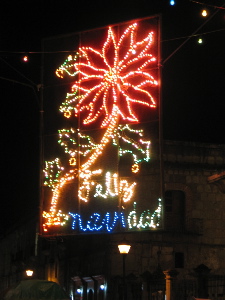
Thankfully our good friend Nilofour King came to stay with us. She played piano for Christmas carolling. The level of cooking knowledge in the house rose a number of degrees. Nilofour made both ponche and rompope, two great seasonal drinks--ponche, a wonderful fragrant spiced cider and rompope, a deadly addictive egg nog relative.
Nilofour was able to go to the Noche de los Rabanos for the first time--she's been waiting for 30 years. Night of the Radishes comes each December 23rd and is a celebration specific to Oaxaca. People harvest old, gangly radishes and carve some amazing things with them. Nilofour was not disappointed. The lines were 1.5 hours long to get into the Zocalo.
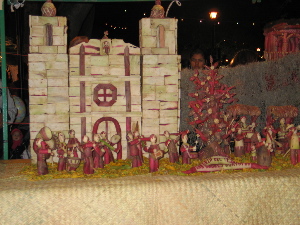


Muriel and Leland were asked to be a part of a local posada, celebrating the passage of Mary and Joseph to Bethlehem and trying to locate a place to stay.
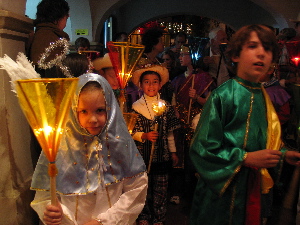
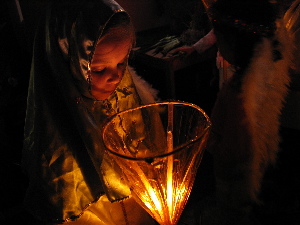

Muriel was Mary. Leland, well, Leland was playing the part of an angel. The posada came to our door, visited our creche/nativity scene, milled about and went on to where the party was happening. The last stop is, of course, the inn that has the room (in the manger). Pinatas, ponche (not as good as Nilofour's!), and tamales. Nerve-wracking to walk down Oaxacan streets with kids. The vehicles seemed forgiving, if just for the passage of the pilgrims. Candle-powered lamps bursting into flame if held at the wrong angle. Just clean fun.


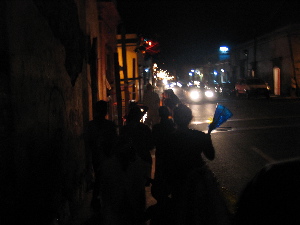
On Christmas Eve, four new additions to the home as Nilofour returned to the states. Lynne (Tracy's sister/Alta's daughter), her girlfriend Susie, and their two dogs What What and Alice B. Poodle. And a boatload of packages from the North Pole.

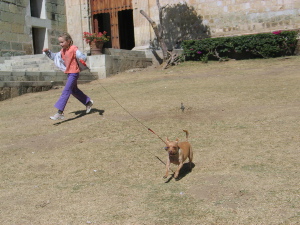
Wednesday, December 29, 2004
Thursday, December 16, 2004
LA VIRGEN DE GUADALUPE
"Dark hair and dark eyes, just like me."
In 1531, recently after the Spanish razed the breathtaking Aztec capital Tenochtitlan to make Mexico City AND had destroyed their sacred places and outlawed their religion, an Indian named Juan Diego was walking through the hills just north of the new city. The region is arid, rocky and inhospitable for most life forms. Desert. As he passed the hill of Tepeyac, once the home of Tonanzin, temple for the gentle goddess of earth and corn, he smelled a heavenly fragrance and heard celestial music. He stopped in the midst of a brilliant light, and the blessed Mother Mary emerged, robed in blue and gold and rose. But this incarnation of the Virgin had Indian features.
It took Juan Diego three times to convince the bishop to build a shrine on the ground where she had appeared. Finally Mary told Juan to pick the Castillian roses that were miraculously growing at the place. He filled his tilma, or white muslin cape, with the roses and went to the bishop. Upon arriving at the Cathedral of Tlatelolco the Spanish fathers could see the image of the Blessed Virgin emblazoned on the tilma, the blossoms pouring out at the image of her feet. This was good enough for them.
[recap, paraphrased from a Barbara Lyons article]
----
Our own Virgen de Guadalupe story began with a mid afternoon comida. The day before the festivities actually start, the city is expectant. The worshippers will form lines to enter the church late that night. The next two days will be filled with celebration--children dressed as Juan Diego or a female contemporary parade from El Catedral at the Zocolo to el parque Llano very close to our house. The park will be filled with vendors of food and plastic chinese-made anythings and pirated videos and CDs and more food and, of course, the rides. More on the rides later.
As we sat for the comida, the bouganvilla flowers (bugambilia here) continued to flow from their trellis over our outdoor table in the courtyard. The meal was fairly simple for our usual formal sit downs. Frijoles, arroz, aguacate, quesadillas, que mas? No one can quite remember, because at one point I went to help Leland scoot his chair in for the 5th time and I stepped on what I thought was a bugmabilia flower. But it was a bit harder than a flower. And out of my peripheral vision, it now seemed to be rolling back and forth in a way that made me swing the chair away and gasp. It was the largest worm I have ever seen. Nobody saw it walk in, and no one invited it. I had just stepped on its head. El gusano grande!
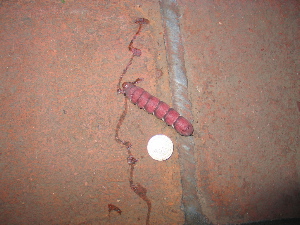
The thing was about the size of an italian sausage. The coin you can't quite make out was a 10 Peso piece, between a quarter and half dollar in size. The worm's underside was like an uncooked lobster tail. A purple fantail pattern on the bottom. Twelve stumpy legs, each like a plantar's wart. Writhing and draining a streak of clear fluid. This, of course, was no miracle, but it was amazing.
The next day Tracy and I went to Ocotlan for our second time. Previously we had gone for a very busy market day around the Dia de los Muertos during which Alta had her digital camera stolen. That day had been fairly close to a total washout for me and I wasn't looking forward to returning to Ocotlan, but a friend of ours, David Riker, was showing his feature film La Ciudad at the exconvento of Ocotlan's Santo Domingo church. The church that had been restored by Rodolfo Morales. David invited us to go with him and his wife Elizabeth and daughter Leila. Though the film was our main attraction, they promised the best chile rellenos on the planet. This happened to be the case.
One of the comedors lining the main plaza, this one seemed simple enough. But I had forgotten that Elizabeth had told us the daughter of the owner looked like Frida Kahlo. They were running low on chile rellenos, but made more for us. The owner's daughter, Beatriz, arrived with her own daughters about 20 minutes later. She did indeed look like Frida, but you can judge for yourself.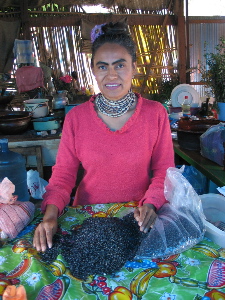
Their comedor stand has two beautiful moles (mole-ays are mixtures of chocolate, chile, and other spices), rojo-red and one that was nut brown. We tried them both as we waited for the chile rellenos. The chile rellenos at this spot are made with Chile de Agua instead of the usual, milder, poblano chiles. The added spice makes all the difference. I'm biased, of course. I like it spicy.
David was led off for a radio interview. It's a funny story in spanish, but the gist of it goes something like this. Morales's nephew came to get David from Beatriz's comedor. David was looking forward to another relleno, but knew he had to go. En route to the radio station, they're a bit late. They run into the radio host outside in his truck. He's drunk. The host says, "You're early, don't worry, we won't start until 5pm. You don't have to come over until then. What time is it?" David says, "530p." So they go to the studio immediately. The man is seriously drunk. Once they arrive, David finds out that the interview is going to be a marathon. One hour. Also, he discovers that he can barely understand his host. The man is talking fast and slurring like crazy. Something like "Mumblemermemerenemenomubmlelemumble, what do you think, David?" In spanish. So David has to guess at what the question was and guess at what the answer should be. For an hour. The whole time, the host is kicking back mezcals, praising Rodolfo Morales, saying that Morales used to use mezcal as a creative tool, etc. and offering shots to David and Morales's nephew who hasn't had a drink in 12 years. Around the time that the film was supposed to start, back at the exconvento, David started getting subtle looks from Morales. Taking his cue, he started to wrap up, gave his standard "Thank you to the Morales Foundation, the fine people of Ocotlan, etc." When he had finished, the host made sure that David knew that they had 12 minutes left in the hour and he wasn't going to rob his audience of the promised, full one hour show! David made it back in plenty of time to show the film that night.
We went to the church doors to look in on the activity before the film. It was busier than normal. But, then again, it was the festival of the Virgen de Guadalupe. And, in a mixture of dread and thrills, we saw that there would be a quince anos celebration that night during the film. Quince anos is a celebration of a girl's 15th birthday. And in Ocotlan, they celebrate with a big brass band.
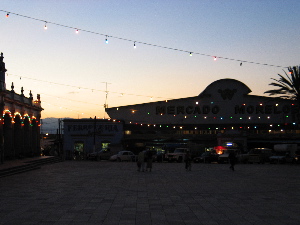
It wasn't long until it was dark. Dark enough to begin the film. The exconvento courtyard began to fill. David's film went without a hitch--for about quince minutos. Then the band and the one-loud-boom fireworks were lit up at the same time. At one point in the film, which is about Mexican and Central American immigrants in NYC, one of the characters says to the other in a very intimate scene in a quiet garden, "Wait, wait, do you hear that? It's like we're back in Mexico." We of course could barely hear this line over the band and the bombs. And it was just like we were in Mexico, too. Through all of this, the film was a treat to watch. Check it out.
On the way home we bought amazingly good ice creams sandwiches. Chocolate and gelato. How did they get here? And as we're driving back we start to feel like we're doing the wrong thing. We should stay out as long as possible. Leila might go to sleep, don't you think? We stop on the side of the road to let a band pass in pitch dark (except for headlights). A perfect band marching down a perfect Mexican street. A little further we see the turnoff for San Martin Tilcajete, the small town famous for their wooden animal carvings called alebrijes. In almost a fit of withdrawl, we pulled to the side of the main San Martin church. Not as restored as the Ocotlan church, but a popular place for the people of the town on this night. Some people were streaming out of the new wooden doors, out of the fluorescent lights into the chill night air. I think we saw the girl dressed as the Virgen de Guadalupe waiting. But for what? Just then, the San Martin band began to play. Just as loudly as the quince aņos band in Ocotlan. And a woman walked into the middle of the park in front of the church. It was there that she lit fire to the fireworks resting anxiously on her head in a large basket. For the next 10 minutes she danced and twisted as the full strength fireworks shot off her head and into the trees and sky, and sometime glancing off the ground (oops) and the band played.
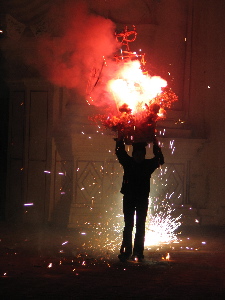
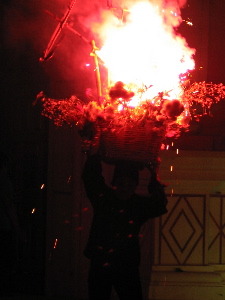
After the missiles landed and smoked themselves out, we went into the church. A few people were left. And is the case with so many people in the state of Oaxaca, one young man asked us where we were from. Did we come from the US, for he, too, had been in the US and has a brother there. We marveled at the gruesome depiction of the life and death of Christ. The old worm-eaten doors were on display, too. Like relics themselves from a time of spanish rule, eaten by the truth of the land and the insects and the people. As we walked back to the car, more greetings. "You should go down the road to the rest of the celebration," the guy with a brother in the states said. "If you think tonight was fun, you should come back for Noche Buena (Christmas Eve)." I couldn't help think immediately of how the tables turn if these open people, most gracious hosts, if they would tromp unannounced and uninvited into the middle of a Christmas eve party in any town east of the Pacific and north of the Rio Grande.
After dragging our feet to the car, we left. David and I sat in the front seats. Elizabeth finished her ice cream sandwich. Watching for topes (speed bumps) in the dark, David warned Tracy that he and I both were going to learn the tuba and get steady work as freakishly tall white tuba players in as many bands as possible. The tuba doesn't really appeal to me. There's never much flourish in the playing of a tuba. But I could learn.
Monday, December 13, 2004
MEXICAN LIFE, ALTA TINGLE 13 DEC 2004
Make no mistake, Mexico is not tranquil. Here in the city center, we hear bands playing, fireworks exploding and a general hustle of traffic and conversation that starts early and goes well into the night. This is a culture rich in history and pageant. And it happens on the street. On Friday mornings a woman parks her not new station wagon on our corner, opens the tailgate and sells home made sweet rolls, donuts and cookies along with coffee and hot chocolate. I've no idea whether it is a once weekly endeavor or perhaps she has various corners through out the week. She certainly has an avid clientele on Fridays. Most corners have a regular cart that might sell tamales or fresh fruit that is peeled and ready to eat.
One of my greatest pleasures is the abundance of flowers. Many women come into town, riding a bus for three hours, to bring bundles of freshly cut flowers from their gardens. You might imagine arms full of calla lilies and they are ubiquitous, but that is just the beginning. There are roses of all colors, fragrant gardenias, gladiolas, spikes of flowers from aloes and red-hot poker, and many mysterious blooms that are irresistible. Often the foliage accompanies the flowers making the generous arrangements that I place about the house seem both personal and original.
Outside our kitchen we have iron stands holding the large shallow baskets, usually used for bread delivery, ours are full of chilies, limes, avocados, papayas, melons, onions, and other fruits and vegetables. It is a constantly changing assortment that challenges us to try new ways to prepare this magnificent cuisine. Diana Kennedy's books are kept close at hand. We've come to think that the refrigerator is empty if it does not contain a licuado (my favorite, so far, is made from passion fruit) and at least one salsa fresca. Needless to say tortillas are always included in our meals and black beans (which my four year old grandson calls dinner beans) are cooking on the stove nearly every day.
Like all Mexican homes, no space is idle. At our house the washing machine and scrubbing sink are in a covered outdoor space and the roof is home to two rabbits, our sunny breakfast table on weekends, and the place where we hang the clothes to dry. It happens that it is also beautiful, with plants in pots and vine-draped walls. the ceiling is bamboo slats and blue sky. It was the perfect place to watch the total eclipse of the moon, in October. We've been known to sip mezcal and enjoy all the phases of the moon from this utilitarian spot.
Since our sala surrounds an open-air courtyard, there are times, at night, when we retreat to our beds for warmth and comfort. It is not unusual to get up and go out later. Sometimes it is not to eat or drink but to feel the air and the life on the street. All manner of people, from vendors selling rebozos and baskets to young lovers aware only of each other, and people heading home after work or visiting one of the many cafes, the only thing for sure is that there will be a variety of activities to view or participate in.
Our trips out of town are limited, as we do not have a car. The freedom from worries, about traffic and parking and safety far out weigh the limitations. Occasionally we rent a car for a day or hire a taxi by the hour. The latter is our preference because we enjoy the conversations with the drivers and always glean information. Riding buses in town is rare, most drivers have a shrine surrounding their rear view mirrors and a helper who hops off the bus at each stop to shout the destination of his driver. It is as if he were selling an excursion. We have decided the drivers must be paid by the volume of passengers. It makes for a lot of fast stops and woe unto the passenger who does not shout out his stop well in advance. These jockeys all behave as if they are in a race.
--Alta Tingle
Sunday, December 05, 2004
ANY QUESTIONS?
This blog has been a bit one-sided. Most of you who are reading have yet to comment. Here's how. At the bottom of the entry there is a
"posted by xxxx at xx:xx am | # comments (a letter icon with an arrow pointing to the right)"
Follow these steps to post a comment.
- Click the comment link. This takes you to a page with only one blog entry on it.
- Below the end of the entry you'll now see: "# comments:" followed by "Post a Comment"
- Click the "Post a Comment" link. This takes you to the "Post a Comment On: Oaxaca Experiment Blog" page.
- Enter your comment in the box, include your name if you want to, then click the "Publish Your Comment" button.
- That should do it.
Ultimately the experiment might be more informative for everyone if we get to respond as well as pontificate. It's up to you. So if you are inclined, please let us hear from you. It could be pretty fun.
TR
We're just about at our first 3 month mark. Amazing to think of that. It has that strange sensation of not being that long, and simultaneously being much longer than that. Daily life here is still foreign, though there is a familiarity that comes with time and repetition. I am still enamored with the day to day events...bus ride to Muriel and Leland's school; walks through town; visits to the mercados.
I continue to take a lot of photos. I'll try to figure out how to post a few (undoubtedly I'll have to enlist Thom's help). I know Thom has posted some already of Hierve el Agua, etc. I'd like to post a few from some series that I'm having a good time with--bus altars, wall maps.

Almost every bus has some sort of religious altar in the front, ranging from minimal (a sticker of christ on the rearview mirror, or over the top area) to the extravagant (figurines surrounded by plastic flowers, glowing lights, curtains, strobe lights, and on). There are often interesting juxtapositions of imagery to the altars--a daffy duck doll, tweety bird stickers, futbol flags.
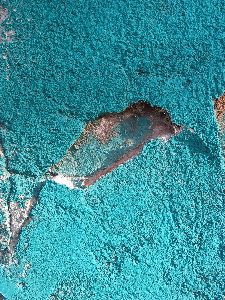
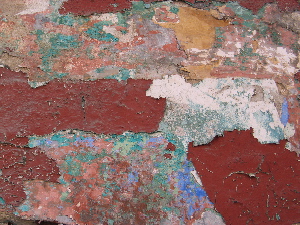
The "wall maps" are of crumbling plaster/adobe walls that have shapes that resemble maps--though I am now also delving into the patinas and shapes left by many layers of paint, and many years under the blazing mexican sun.
Things are beginning to get revved up for christmas around here--the usual cheezy decor: trees, santas, lights. We've also spotted some great over the top stuff: jesus with rings of lights flashing around him; mary with the same. Last night there were fireworks/firecrackers going off like crazy. Our friend Pilar who was over for dinner said they were getting ready for the saint's day recognizing the virgin of guadalupe, which isn't for over a week... Things should be at a full fever pitch by next week, not to mention by the time the 25th rolls around.
Muriel and Alta were out at our favorite cafe (Nuevo Mundo), and Muriel was speaking such perfect spanish that Alta was asked if she also spoke english. Yeah, baby! Leland is not as far along as Muriel, but is doing great too. Our wish for having bilingual children is coming to fruition before our eyes. Now, if we can get them into the spanish immersion program in Berkeley, they'll be set.
The constantly sunny warm days are such a delicious contrast to the last 6 winters we endured in Ithaca. It is our weather pallete cleanser. The amount of light is astonishing--bright and intense beyond belief.
Okay, I've been lounging in bed all morning--reading the NYT online, drinking coffee, visiting with Leland and his toys, writing this blog entry--and now it's time to get up, stretch my bones, and go on about the day.
